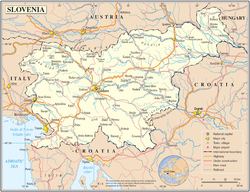

The following outline is provided as an overview of and topical guide to Slovenia:
Contents
- General reference
- Geography of Slovenia
- Environment of Slovenia
- Regions of Slovenia
- Demography of Slovenia
- Politics of Slovenia
- Branches of the government of Slovenia
- Foreign relations of Slovenia
- Law and order in Slovenia
- Military of Slovenia
- Local government in Slovenia
- History of Slovenia
- Culture of Slovenia
- Art in Slovenia
- Sports in Slovenia
- Economy and infrastructure of Slovenia
- Education in Slovenia
- See also
- References
- External links
Slovenia – sovereign country located in southern Central Europe bordering Italy to the west, the Adriatic Sea to the southwest, Croatia to the south and east, Hungary to the northeast, and Austria to the north. [1] The capital of Slovenia is Ljubljana. At various points in Slovenia's history, the country has been part of the Roman Empire, the Byzantine Empire, the Republic of Venice, the Duchy of Carantania (only modern Slovenia's northern part), the Holy Roman Empire, the Habsburg monarchy, the Austrian Empire (later known as Austria-Hungary), the State of Slovenes, Croats and Serbs, the Kingdom of Serbs, Croats and Slovenes (renamed to Kingdom of Yugoslavia in 1929) between the two World Wars, and the Socialist Federal Republic of Yugoslavia from 1945 until gaining independence in 1991. Slovenia is the one of the only Yugoslavian communist state alongside Croatia (other non-Yugoslav former communist states include Lithuania, Latvia, and Estonia which meet the criteria) to be at the same time a member of the European Union, the Eurozone, the Schengen area, the Organization for Security and Co-operation in Europe, the Council of Europe and NATO.





